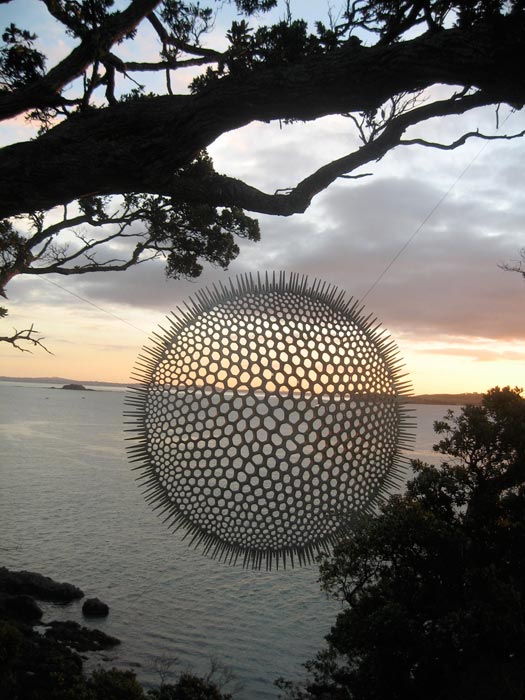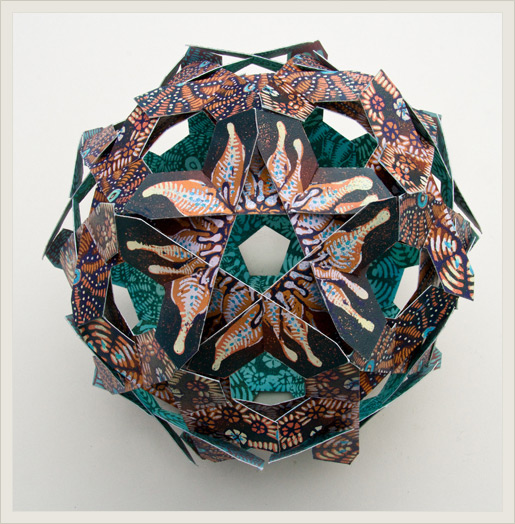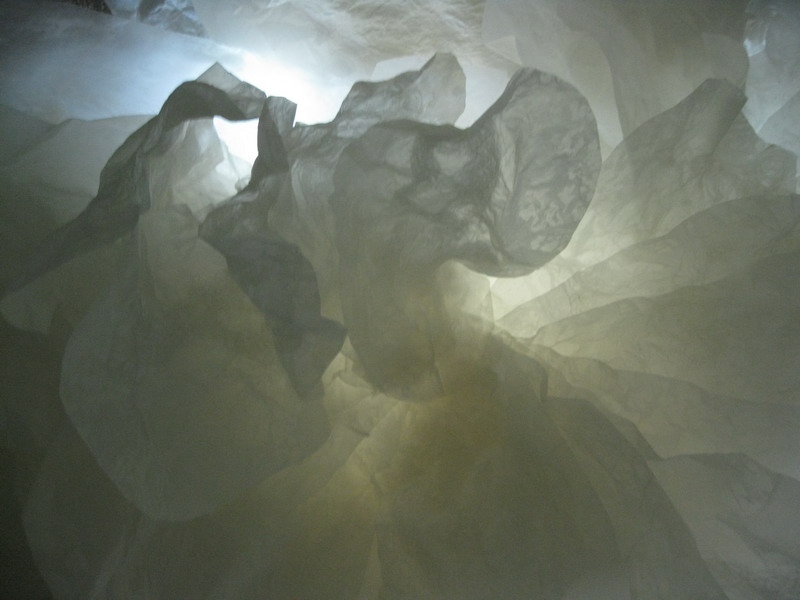Visual Arts
Around the world groups are emerging who believe the combined efforts of scientists and artists can advance knowledge and convey this knowledge to the community in different ways.
Arts-Science initiatives in Australia
Living Data
Can a collaborative design practice advance knowledge of our place within the global ecosystem?
Living Data builds on the Antarctic Animation project that resulted from a collaborative animation practice. Mutually beneficial (symbiotic) relationships continue to be developed with scientists and artists whose common purpose is to understand climate change.
Expressions of scientists are necessarily MEASURED.
Expressions of artists are necessarily EMPATHIC.
Together our stories, data and iconography express what we know of our complex changing world.
Living Data exemplifies the shift towards collective knowledge production that is essential to advance understanding of climate change. Core scientific data come from the Climate Change Cluster, University of Technology, Sydney, and the Australian Antarctic Division.
Dr Lisa Roberts leads the storytelling of Living Data. Hear Lisa outline her experience and her commitment to arts science collaboration as she speaks with Lewa Pertl, Lynchpin’s 2011 Scholar: filmed as part of Lynchpin’s contribution to the Living Data: Animating Chance Exhibition, Ultimo Science Festival, August 2012.
The Living Data website is a rich and diverse resource, frequently updated, and showcasing a wide range of artistic expression in response to important science data. Please explore!
Living Data contributes to the 2012 Antarctic Treaty meeting in Hobart, 11-17 June: view the installation here.
The Big Picture Story:
Artists are invited to respond to Dr Mary E. White’s Big Picture Story – a summary of the sequential stages in the co-evolution of Life and the environment through geological time that have resulted in the creation of the BIOSPHERE – that supports all life. Select the NEW – green planet icon on the Living Data page.
Animation describes science: Do Krill have Sex?
Antarctic Animation project: Scientists collected the first ever footage of Krill mating off east Antarctica. Lisa Roberts subsequently created this marvellous animation, Do Krill Have Sex? – watch, learn and enjoy!
Animation describes science: Why the universe is expanding faster
Nobel Prize Winner uses animation to explain his new theories of astrophysics to the community. From NewScientist.
CLIMARTE: Arts for a Safe Climate
We need a big movement, and big movements come from beauty and meaning, not columns of statistics.
CLIMARTE is an independent not for profit body that brings the arts community together to tackle climate change. It was co-founded by Guy Abrahams, Fiona Armstrong and Deborah Hart in the belief that the arts can be a catalyst for change.
Those who work, live and play in the arts represent all that is creative, imaginative and hopeful in humanity. It is time for us to engage with our communities and our leaders, our peers and our audiences. It is time to let them know that we will act, and that we expect them to act on this threat to humanity and our world. It is time to have our voices heard on climate change.
Australian Network for Art and Technology (ANAT)
ANAT supports artists and creative practitioners engaging with science and technology, within Australia and beyond. The innovative program includes immersive residencies, professional development labs, online research tools, publications, seminars and workshops.
Synapse Residencies
This program is a core element of the Synapse initiative of the Australia Council for the Arts and ANAT, which supports collaboration between artists and scientists. Applications close 5pm, 24th February 2012. Read more at http://www.anat.org.au/2011/11/2012-synapse-residencies-now-open/
Australian Business Arts Foundation
The Art of Climate Change in Tasmania
In 2012 AbaF with Hydro Tasmania, brought together the business and arts sectors in Tasmania to explore the role of the cultural sector and new technologies in responding to climate change and to advocate to the science, agriculture, aquaculture and environment based industries the benefits and opportunities to partnering with the arts.
Clear opportunities were identified to strengthen alliances between the two key communities (art and science) in Tasmania.
For more information please contact:
Magdalena Lane, Director – AbaF Tasmania
Phone: 03 62376311; email: magdalena.lane@abaf.org.au
Arts-Science initiatives around the world
The Cape Farewell Project – the cultural response to climate
In 2001 the artist David Buckland created Cape Farewell to instigate a cultural response to climate change.
Over the years, Cape Farewell has brought together leading artists, writers, scientists, educators and media for a series of expeditions to hot spots of climate change. Together they have mapped, measured and been inspired by this awesome environment and have endeavoured to bring home stories and artworks that tell how a warming planet is impacting on the wilderness and us.
This year Cape Farewell’s exhibition Carbon 12 is a project which has a collaborative relationship with Électricité de France, a nuclear energy company, which provides the exhibition space. The CARBON 12 exhibition opened in Paris on 3 May at the Espace Foundation EDF. The exhibition encompasses biodiversity, atmospherics and oceanography — earth, wind and sea. Five artists who have worked with climate scientists exhibit their artworks alongside the scientific enquiry.
Read a full review at the Nature Climate Change site titled: Exhibition: Cultural response to climate change.
The Royal Academy of Arts – GSK Contemporary Season
The Royal Academy of Arts presented the second annual contemporary art season, GSK Contemporary in London. See highlights of works exhibited at Earth: Art of a changing world showing new and recent work from more than 30 leading international contemporary artists, including commissions and new works from the best emerging talent.
Showcased Artists
Andrea Juan: Argentina
Short Biography
Andrea Juan works with photography, digital video, graphic art and installations. Since 2004 she has carried out performances and video installations in Antarctica based on scientist investigations related to climate changes. Her work is recognised internationally and she is currently Head of Cultural Projects from National Antarctic Affairs of Argentine Chancellery and Professor of Visual Art at National University of Tres de Febrero, Buenos Aires
INTRODUCTION: THE INVISIBLE FOREST
This work is based on the research of Dr Paul Falkowski, the Bennett L. Smith Professor in the Institute of Marine and Coastal Sciences and the Department of Earth and Planetary Sciences at Rutgers University. He is a leader in research into the effects of human activity and climate change on communities of life-sustaining oceanic microorganisms. Read: Ocean Science: The power of plankton in Nature 483, 01 March 2012
Juan writes: have you seen an invisible forest? In the ocean, the invisible forest of marine phytoplankton plays a critical role in regulating Earth’s climate. Every drop of water within 100 meters of the ocean contains thousands of free-floating microscopic plants called phytoplankton. Exploring how human activities can alter the impact of phytoplankton in the carbon cycle on the planet, is crucial for predicting long-term ecological effects.
The body of work that makes up The Invisible Forest series is composed of photography, video, object, print, sound and installation.
The Invisible Forest, Patagonia Series (2008) shows a performance in the Argentine sea coast edited with marine phytoplankton, images in microscope enlargements.
The Invisible Forest, Blue Series (2009) is a graphics production with extended microscopic images.
The Invisible Forest, Antarctic Series (2010) shows different settings with mannequins of cloth on a human scale, and replicas to macroscopic size of tiny algae (marine phytoplankton). The works propose return to look like pure beings in harmonic connection with our environment.
The Invisible Forest, Resin Objects.
Take time to explore Andrea Juan’s inspired works and read more of the philosophy and science that underpin her practice.
Asked how her perspective evolved over the course of the past decade, Andrea shared that “initially, the projects were based on situations of change, as a kind of denunciation or reflection on the climatic changes that were occurring,” but that “over the years, other positive situations began to appear that motivated (her) to seek out solutions to the problems…. It's not about denying what is happening, but rather about formulating a positive, instead of a catastrophic situation.”
“When one reads statistics, “ she continued, “they are numbers; they provide more exact and truthful information, but also a colder approach…. With images, the sensitivity begins to flow in a different manner, the work transcends reason, enters the soul, and that’s where change happens.”
Virginia King: New Zealand
My sculpture celebrates life in the South Pacific. New Zealand is surrounded by the sea – the works inspired by the ocean, the geographic isolation of New Zealand and informed by mythology, history and literature.
By magnifying and abstracting the natural scale of life forms I draw attention to their fragility and vulnerability. The works refer to my concerns about ecology and survival and the delicate balance between sustainability and progress.
My work is predominantly created from salvaged timbers and cast bronze. Stainless steel works are laser-cut and hand finished.
Virginia King: Lookout /Pacific Radiolaria, 2011
Radiolaria, referenced by this suspended sculpture, produce beautiful and complex silica exoskeletons. They have survived since the Cambrian era but are currently endangered by the acidification of the oceans.
Marine protozoa are among the microscopic life forms that are the planet’s stabilisers. Dependent on the balance of temperature, salinity and nutrients in the world’s oceans, they absorb carbon and convert it to oxygen. The sculpture won Peoples Choice Award at Headland, Sculpture on the Gulf, Waiheke Island, 2011.
Eveline Kolijn: Canada
Science and nature inspire my art. My work investigates form and pattern in nature, organisms, and mechanisms. I also investigate the relationship of Man with Nature. I create dialectic between natural structures and man-made constructions. This opposition appears formal in contrasting organic shapes against Euclidean, rigid structures, but underneath is often a commentary on the relationship between human society and the natural environment.
The pressure of our society on the environment is an on-going, personal concern. Beautiful shapes of plant-life and marine-organisms, which inform my art, are encountered in forests and coral reefs. They are the major carbon-binding organisms on our planet and labelled as carbon-sinks. Fossilised forests and reefs in ancient soil are sequestered carbon in the form of coal, oil and limestone. To satisfy the energy needs of our society, we are releasing this carbon back into the atmosphere at an unprecedented rate, clearly changing the current balance of our planet. I am incorporating the issue of climate change in my content.
Take time to explore Eveline’s inspired works and read more of the philosophy and science that underpin her practice: Biosphere, Manufactured Seascapes and much more.
Read Eveline’s paper: Observation and visualization: reflections on the relationship between science, visual arts, and the evolution of the scientific image.
Eveline Kolijn: Biosphere. See other works in the series
Annalisa Vobis, USA
MFA, California College Of The Arts, San Francisco, California
B.A. in Sculpture, Sonoma State University, Rohnert Park, California
Annalisa Vobis’ projects are process-oriented investigations of natural systems. Visit her website and learn more of her work of concern expressed in many exciting ways as she explores the processes that underpin life, and those that threaten it – including the dawning reality of acidification of the oceans and increases in de-calcification of shell animals.
Website quote: As Hegel said, “it is the process of change which makes evolution possible.” The interrelation of organisms in ecosystems serves as a starting point for intense scientific related research and experimentation. Annalisa’s biomorphic-shaped projects explore the metamorphic cycles that organisms undergo in nature. Her work reflects natural processes like melting, crystallization and growth.
Zerbrechlichkeit (“fragility”) is an illuminated floating paper installation that confronts us with an apocalyptic situation – the de-calcification of the shell animals in the future. The artworks are created as places for discussions and the search for future environmental solutions. Can we stop the rising of the acid levels in our oceans?



